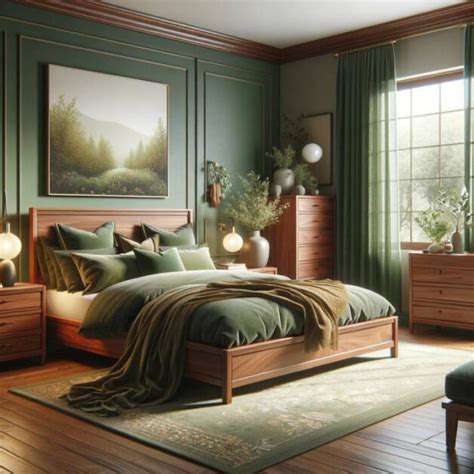The ultimate guide to designing your bedroom with wooden furniture
Choosing the Right Wood for Your Style
Choosing a Warm and Inviting Feel
When designing a bedroom that radiates warmth and comfort, cherry or walnut woods make excellent choices. These deep, reddish-brown varieties establish a soothing environment, ideal for spaces prioritizing relaxation. The organic grain patterns introduce visual depth and character, elevating the room's sophistication. Plush fabrics, gentle illumination, and cozy seating arrangements complete this welcoming atmosphere perfectly.
Lighter options like maple or birch can achieve similar warmth while creating an airier sensation, particularly when combined with pale bedding and decor. These varieties help smaller bedrooms feel more expansive and open.
Emphasizing Modern Aesthetics
Contemporary bedroom designs thrive with streamlined silhouettes and minimalist approaches. Ash or oak varieties, featuring straight, uncomplicated grain patterns, align beautifully with this aesthetic. While showcasing wood's inherent beauty, these selections maintain an air of refined simplicity. Pair them with geometric furniture shapes to fully realize a modern design vision.
Creating a Rustic Charm
Bedrooms embracing rustic or farmhouse styles benefit from pine or reclaimed wood selections. Their natural imperfections and textured surfaces cultivate a cozy, lived-in atmosphere. Reclaimed materials particularly shine, adding historical depth and unique personality to the space.
Considering Durability and Maintenance
Furniture longevity depends heavily on wood selection. Hardwoods like oak, maple, or walnut withstand daily wear better than softer alternatives. Assessing your lifestyle and expected furniture usage ensures you choose materials that maintain their beauty through years of enjoyment.
Budget-Friendly Options
For cost-conscious decorators, pine or fir provide accessible alternatives. While less durable than premium hardwoods, these options allow for stylish bedroom designs without excessive expenditure. With careful selection, affordable woods can still create inviting, personalized spaces.
Creating a Balanced Layout with Wooden Furniture
Understanding the Principles of Balance
Successful furniture arrangement extends beyond symmetrical placement, requiring consideration of visual weight and texture interplay. Larger pieces demand thoughtful counterbalancing, while darker finishes or intricate details appear visually heavier. Mastering these concepts prevents spaces from feeling overcrowded or disjointed.
Utilizing Symmetry and Asymmetry
Symmetrical arrangements establish order, particularly in traditional settings, but benefit from subtle variations to avoid stiffness. Asymmetrical approaches offer creative freedom, allowing dynamic focal points and personalized flows that maintain visual harmony.
The Role of Scale and Proportion
Furniture dimensions should complement room size - oversized pieces overwhelm small spaces, while diminutive items get lost in larger areas. Proper scaling creates comfortable, intentional environments that feel neither cramped nor sparse.
Incorporating Color and Texture
Wood finishes interact with room color schemes significantly. Dark furniture pairs beautifully with light walls and textiles, while varied wood grains add depth. Combining smooth and textured surfaces prevents monotony and enhances visual interest.
Accessorizing for Visual Balance
Strategic accessory placement completes room designs. Rugs anchor spaces, artwork establishes focal points, and plants introduce organic vitality. These elements work synergistically with furniture to create cohesive, inviting environments.
Creating Focal Points and Visual Pathways
Intentional focal points, like statement artwork or architectural features, guide eye movement through spaces. Thoughtful furniture placement enhances these visual journeys, resulting in naturally balanced, engaging rooms.
Accessorizing Your Wooden Bedroom for a Personal Touch

Adding Texture and Dimension
Layering textures enhances wooden bedrooms exponentially. Plush area rugs, knitted throws, and varied pillows transform spaces into tactile retreats. Natural fiber selections like jute or wool complement wood tones while adding organic contrast.
Incorporating Metal Accents
Metallic elements introduce contemporary flair against wood's warmth. Brass lighting fixtures or iron decorative pieces create striking juxtapositions that elevate traditional wood aesthetics.
Strategic Use of Lighting
Layered lighting schemes showcase wood's natural beauty. Ambient fixtures establish base illumination, while directional lights highlight architectural details or artwork, creating dimensional interest.
Selecting the Right Fabrics
Fabric choices significantly impact room ambiance. Luxurious linens or rich velvets in complementary hues enhance both visual and physical comfort, creating cohesive designs. Patterned textiles add personality when balanced with the overall color scheme.
Mirror Magic and Visual Tricks
Well-positioned mirrors amplify light and space perception. Large mirrors opposite windows maximize natural light, while decorative pieces add glamorous accents. These reflective surfaces create illusions of expanded space and added grandeur.
Adding Greenery and Natural Elements
Indoor plants breathe life into wooden spaces, improving air quality while enhancing natural aesthetics. Wood carvings or stone accents further connect interiors with outdoor inspiration.
Color Coordination for a Cohesive Look
Accessory colors should harmonize with wood tones. Soothing palettes of blues, greens, or neutrals cultivate relaxing environments, while bolder accents inject energy and personality. Consistent color stories unify all design elements beautifully.

- Creating a Tranquil Environment for Improved Mental Wellbeing
- The best wood types for furniture that lasts
- Best wooden dining tables for large family gatherings
- Best wooden furniture options for large living rooms
- Why solid wood furniture is the best investment for your home
- How to balance large wooden furniture in open plan spaces
- How to create an industrial inspired space with wooden furniture
- How to fix scratches and dents on your wooden furniture
- How to create an industrial chic look with wooden furniture
- How to choose the right wooden furniture for your home office
- The best ways to combine wood with other natural materials in your home
- How to match your wooden furniture with your interior design style